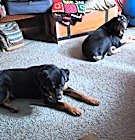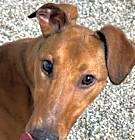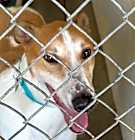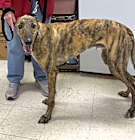A Maltese is a small dog, with a long, silky white coat that flows to the ground (you’ll often see it tied up in a topknot to keep it out of their eyes). Their expressive dark eyes and black nose are set against their white fur, giving them a sweet puppy-dog look. Maltese dogs have a compact, well-proportioned body, a plume-like tail that arches over their back, and feathering on their ears.
Maltese
Breed Type: Toy
Coat: Silky
Hypoallergenic: Yes, they may not trigger allergies.
Temperament: Affectionate, lively, loyal, gentle
Life expectancy: 12-15 years
Color & patterns: White

The Maltese is a small bundle of joy who will steal your heart. With their petite size and luxurious white coats, they resemble fluffy clouds that bring a touch of elegance to any room. Don’t let their small stature fool you, though, as they are brimming with confidence and personality. They thrive on human companionship and are incredibly devoted to their families. Whether you’re lounging on the couch or taking a stroll in the park, the Maltese will be right by your side, showering you with endless affection.
Maltese characteristics
Learn about about Maltese basics like their fur colors, shedding levels, how much grooming they need, and other Maltese facts.
Average height
8-10 inches (20.3-25.4cm)
Average weight
5-13 pounds (2.3-5.9 kg)
Average lifespan
12-15 years
Exercise needs
Grooming needs
Full-grown size
Good with cats
Good with kids
Training aptitude
How big do Maltese get?
Maltese weigh between four to seven pounds and stand about seven to nine inches in height at the shoulder. Their compact size and light frame make them a portable and charming companion, well-suited for indoor living, and easy to carry around.
Are all Maltese white?
Yes, all Maltese are white, but they can occasionally have shades of light tan or lemon on their ears or around their eyes. These variations in color are often considered "off-white" or "ivory." However, for purebred Maltese dogs, the vast majority of their coat should be a beautiful, silky white, and the presence of any significant color other than white is considered a deviation from the breed standard.
Do Maltese shed?
No, Maltese do not shed. While they don't shed in the traditional sense, their hair can break and become trapped in their coat, which may require regular grooming to prevent matting and maintain their silky appearance.
Maltese are one of the few breeds that boast a hair-type coat instead of a fur-type coat. Their hair-like fur is one of the main reasons Maltese shed so little. Hair has a longer growth cycle than fur, so it takes longer to grow, die, and eventually fall out. Maltese have a single coat so they do not experience heavier seasonal shedding.
Do Maltese have hair or fur?
Maltese dogs have hair rather than fur. Their coat is unique, consisting of long, silky hair, and it doesn’t have the undercoat typical of many other breeds with fur. This distinction contributes to their reputation as a low-shedding and often hypoallergenic breed. The long hair, which can grow quite lengthy, requires regular grooming and care to maintain its elegant appearance and prevent matting.
How long do Maltese live?
Maltese live between 12 to 15 years. With proper care, adequate nutrition, regular exercise, and routine veterinary check-ups, some Maltese dogs can live even longer. Their longevity is a reflection of their small size and robust health, although individual factors, such as genetics and overall care, can influence their lifespan.
Can a Maltese be a service dog?
Yes, Maltese can be service dogs. Their small size and warm-hearted demeanor can make them effective emotional support animals or therapy dogs, provided they meet the necessary training and temperament requirements. However, they are less commonly seen in service dog roles compared to other breeds, as their size may limit their ability to perform certain physical tasks.
Is a Maltese a terrier?
No, a Maltese is not a terrier. Maltese dogs belong to the toy group of dog breeds, known for their small size, graceful appearance, and affectionate temperament. Terriers, on the other hand, are a distinct group of breeds known for their tenacity and hunting abilities.
What is a Maltese?
A Maltese is a small breed of dog known for their long, silky white coat and gentle and affectionate nature. They have a lively and playful temperament and are well-suited for both families and individuals.
When do Maltese stop growing?
Maltese stop growing around 12 months of age, although they might continue filling out and developing muscle mass until they’re 18 months to 2 years old. While their growth in terms of height stabilizes relatively early, their physical and behavioral development continues for a bit longer. Proper nutrition, regular exercise, and attention to their specific health needs during this growth phase are essential to ensure they become healthy and well-proportioned adults.
Are Maltese hypoallergenic?
Yes, Maltese dogs are often considered hypoallergenic because they produce fewer allergenic proteins found in their dander, saliva, and urine compared to some other breeds. This can make them a more suitable choice for individuals with allergies, although no dog breed is entirely hypoallergenic. People with allergies should spend time with Maltese to assess their personal tolerance and consider the dog’s grooming and care needs to minimize allergen exposure.
Which is better, Maltese or Maltipoo?
Maltipoos can be better than Maltese in some ways, as they are a mixed breed that inherits qualities from both parent breeds. They can be hypoallergenic, have a wavy coat, and have a variety of coat colors, like Poodles do. Maltese dogs, on the other hand, are a pure breed known for their solid white coat and loving temperament.
The decision between a Maltese and a Maltipoo comes down to factors like the specific traits you desire, grooming requirements, and the characteristics that best align with your living situation and family.
How many types of Maltese are there?
There is one type of Maltese dog recognized by breed standards. While variations in coat texture or color may occur in individual Maltese dogs, these are not considered distinct types within the breed. The breed standard emphasizes specific traits like coat quality, size, and overall appearance, which are consistent among Maltese dogs.
Maltese history
Learn about where this Maltese came from!
What were Maltese bred for?
Maltese were bred for companionship. Their history dates back over two millennia, and they were favored by ancient aristocrats, including the Greeks, Romans, and Egyptians, who treasured them as charming and loyal lapdogs. Maltese dogs were not bred for specific working purposes, but rather for their elegant appearance, gentle temperament, and devoted nature.
Where are Malteses from?
Maltese dogs originate from the island of Malta in the Mediterranean. This breed has a long history, dating back over two thousand years, and is one of the oldest toy breeds. Maltese dogs were cherished by nobility and royalty throughout various ancient civilizations, including the Greeks, Romans, and Egyptians. They were bred for their charming appearance and affectionate nature, making them favored companions for aristocrats and travelers.
Maltese temperament
Learn about about the Maltese temperament and how well they fit into your lifestyle, home environment, and family.
Are Maltese good with kids?
Yes, Maltese dogs are good with kids when they are well-socialized and accustomed to children from a young age. Their gentle and affectionate nature makes them potential playmates and companions for kids.
However, due to their small size and delicate frame, it’s crucial to teach children how to interact with the dog respectfully and gently, minimizing the risk of accidental harm. It’s also important for pet parents to teach their dogs how to gently interact with children.
As with any breed, it is recommended that your child is always supervised when interacting with your Maltese to keep both the child and dog safe.
Are Maltese easy to train?
Yes, Maltese dogs are easy to train. While they are intelligent and can be trained effectively, they may display some independent tendencies that can present training challenges. Their affectionate and eager-to-please nature makes them responsive to positive reinforcement techniques. Early training and socialization are crucial to mold a well-behaved Maltese. Just keep in mind that even if a certain dog breed is known to be easy to train, training a dog requires a long-term commitment.
Do Maltese bark a lot?
Yes, Maltese tend to bark a lot, as they are alert and protective by nature. Their small size and energetic temperament can make them reactive to changes in their environment. While their barking can be seen as a way of alerting their pet parents to potential threats or unfamiliar situations, it’s important to provide your Maltese with consistent training and socialization to manage their barking tendencies.
Are Maltese good dogs?
Yes, Maltese are considered good dogs with an affectionate nature and lively temperament. Their small size and adaptability to various living environments, including apartments, add to their appeal. When properly cared for, they can be loving, loyal, and well-behaved pets, making them a great choice for those seeking a devoted four-legged family member.
Are Maltese smart?
Yes, Maltese dogs are smart. They may be small, but their intelligence is notable. They can quickly learn commands and respond well to training, making them capable of a wide variety of tricks and tasks.
Are Maltese good with cats?
Yes, Maltese dogs are good with cats. While their gentle, loving nature can promote positive interactions, Maltese have a territorial disposition, which may require supervision and gradual introductions to ensure the comfort and safety of both the cat and the dog. Creating a good relationship between a Maltese and a cat involves monitoring their interactions, facilitating positive encounters, and recognizing and respecting the unique personalities of both pets.
Can Maltese swim?
Yes, Maltese can swim, but their small size and light build can make swimming more challenging compared to larger, more water-oriented breeds. It’s important to introduce them to water gradually and ensure they wear a well-fitting canine life jacket for safety. While some Maltese may take to water naturally, others may need more time and encouragement to feel comfortable swimming. Supervision is essential, especially around pools or other bodies of water, to prevent accidents and ensure their safety while enjoying the water.
Maltese health
Learn about about the Maltese health outlook and what diseases they may be prone to at various stages of their life.
Do Maltese need grooming?
Yes, Maltese dogs require regular grooming to maintain their distinctive long, silky coat. Their hair can grow quite long, which can lead to matting and tangling if not cared for properly. Regular brushing, ideally on a daily basis, is necessary to prevent tangles and keep their coat in good condition. Many Maltese parents choose to keep their dog’s coat trimmed short for easier maintenance. In addition to brushing, regular baths, ear cleaning, and nail trimming should also be part of their grooming routine. Professional grooming may be needed periodically to ensure their coat remains healthy and free from mats.
Do Maltese have health problems?
Yes, Maltese have health problems they’re more prone to, including:
Patellar luxation: Also known as slipped kneecaps, this is a common problem in many dog breeds. Patellar luxation is when slight abnormalities cause the knee joint to slide in and out of place. This can cause pain and occasional lameness. Surgical treatment is available for severe cases, although many dogs lead normal lives without treatment.
White Dog Shaker Syndrome: The Maltese is more prone than other dogs to White Dog Shaker Syndrome, an autoimmune disorder causing full-body tremors. Episodes usually begin at a young age (under three) and are brought on by stress or over-excitement. This condition isn't painful and won't affect your dog’s personality.
Portosystemic Liver Shunt: Portosystemic shunt (PSS) is a hereditary issue that obstructs proper blood flow to the liver. Since the liver is responsible for detoxifying the body, PSS sends the toxins in unfiltered blood to the heart, brain, and other body parts. Signs can include but are not limited to behavioral changes, loss of appetite, hypoglycemia (low blood sugar), jaundice, urinary tract problems, vision problems, and stunted growth. PSS can be life-threatening if not treated early. Antibiotics and diet changes can help in the short term, but surgery is the only permanent treatment for the problem.
Progressive Retinal Atrophy: (PRA) is a group of genetic diseases that affect the retina. They are progressive degenerative diseases and will eventually cause blindness in both eyes. There is no effective treatment to stop PRA.
Others: Maltese can also be prone to hypoglycemia, thyroid disorders, collapsed trachea, asthma, eye problems such as cataracts and corneal ulcers, and dental issues. To identify some of these issues, a veterinarian may recommend hip, eye, and imaging tests for your Maltese.
Popular Maltese mixes
A few common Maltese mixes include:
Maltipoo (Maltese + Poodle)
Malshi (Maltese + Shihtzu)
Malchi (Maltese + Chihuahua)
Morkie (Maltese + Yorkshire Terrier)

Find Maltese puppies near you
Adopting a Maltese
We don't see any Malteses available for adoption in your exact location or cities near you, but here are some adorable similar breeds in Columbus, OH.

Penny
American Pit Bull Terrier Mutt
Female, adult
Westerville, OH
Not good with dogs
Not good with cats
House-trained
Spayed or Neutered
Shots are up-to-date

Lucky
Mutt Labrador Retriever
Male, adult
Westerville, OH
Good with dogs
Not good with cats
House-trained

Barry
Shih Tzu Bichon Frise
Male, 5 yrs 9 mos
Westerville, OH
Not good with dogs
Not good with cats

Henry and Raaz
Rottweiler
Male, adult
Westerville, OH
Not good with dogs
Not good with cats
Needs experienced adopter
House-trained
Spayed or Neutered

Pudge
Greyhound Hound (Unknown Type)
Female, 3 yrs 7 mos
Westerville, OH
Not good with dogs
Not good with cats
Spayed or Neutered
Shots are up-to-date

Woody
Greyhound Hound (Unknown Type)
Male, adult
Westerville, OH
Good with dogs
Not good with cats
Spayed or Neutered
Shots are up-to-date

Reacher
Greyhound Hound (Unknown Type)
Male, 3 yrs 6 mos
Westerville, OH
Good with dogs
Not good with cats
Spayed or Neutered
Shots are up-to-date

Pepper Jack
Greyhound Coonhound (Unknown Type)
Male, 2 yrs 6 mos
Westerville, OH
Good with dogs
Not good with cats
House-trained
Spayed or Neutered
Shots are up-to-date

Penny
American Pit Bull Terrier Mutt
Female, adult
Westerville, OH
Not good with dogs
Not good with cats
House-trained
Spayed or Neutered
Shots are up-to-date

Lucky
Mutt Labrador Retriever
Male, adult
Westerville, OH
Good with dogs
Not good with cats
House-trained

Barry
Shih Tzu Bichon Frise
Male, 5 yrs 9 mos
Westerville, OH
Not good with dogs
Not good with cats

Henry and Raaz
Rottweiler
Male, adult
Westerville, OH
Not good with dogs
Not good with cats
Needs experienced adopter
House-trained
Spayed or Neutered

Pudge
Greyhound Hound (Unknown Type)
Female, 3 yrs 7 mos
Westerville, OH
Not good with dogs
Not good with cats
Spayed or Neutered
Shots are up-to-date

Woody
Greyhound Hound (Unknown Type)
Male, adult
Westerville, OH
Good with dogs
Not good with cats
Spayed or Neutered
Shots are up-to-date




